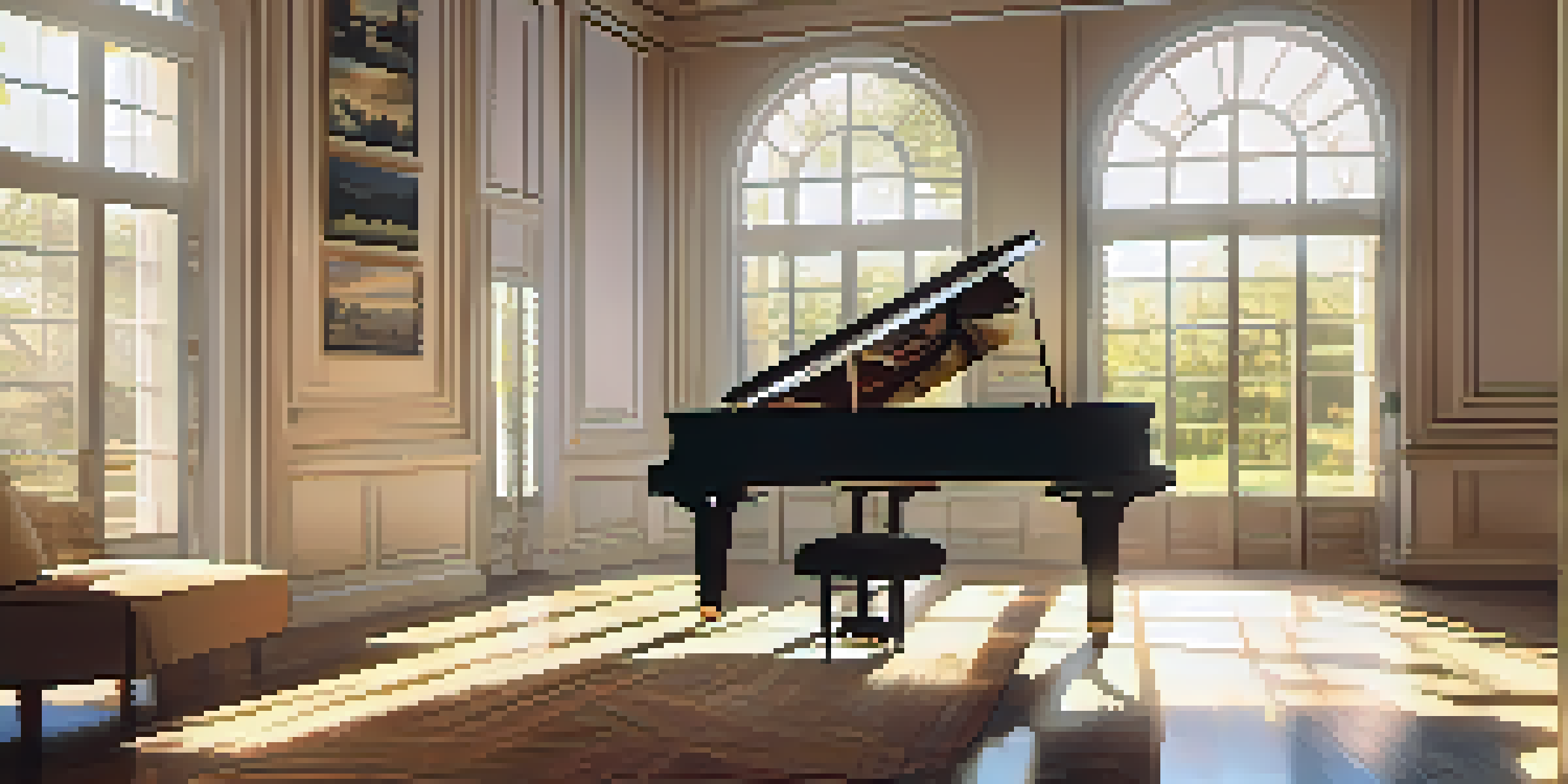Exploring Counterpoint: Adding Complexity to Your Music

What is Counterpoint and Why It Matters in Music
Counterpoint is a musical technique that involves combining different melodic lines to create harmony. It's like having a conversation between two or more voices, each with its own distinct melody but working together to form a cohesive piece. This approach allows musicians to explore the interplay of melodies, adding depth and texture to their compositions.
Music is the shorthand of emotion.
Imagine a delicious dish where each ingredient complements the others – that's what counterpoint does for music. It elevates simple melodies into intricate tapestries of sound, enriching the listener's experience. Understanding counterpoint can open new doors for creativity, pushing composers to experiment with contrasting themes and ideas.
In classical music, counterpoint has a rich history, prominently used by composers like Bach and Handel. However, its principles can be applied across genres, from jazz to pop. By grasping the fundamentals of counterpoint, musicians can infuse their work with complexity and nuance, making their music more engaging.
The Fundamental Principles of Counterpoint
At its core, counterpoint is built on a few fundamental principles that guide how melodies interact. The most basic of these is the idea of consonance and dissonance, where certain notes sound pleasing together while others create tension. This interplay is essential in creating a sense of movement and resolution within a piece.

Another principle is the concept of voice leading, which refers to how individual melodies transition from one note to the next. Good voice leading ensures that melodies flow smoothly, avoiding awkward jumps that can disrupt the listener's experience. Think of it as a well-choreographed dance, where each dancer moves gracefully while still maintaining their unique part.
Counterpoint Enhances Musical Depth
By combining different melodic lines, counterpoint creates a rich tapestry of sound that elevates compositions across various genres.
Counterpoint also emphasizes the importance of rhythm and timing. Different rhythmic patterns can create exciting contrasts between melodies, making them feel more dynamic. By mastering these principles, composers can craft intricate musical conversations that captivate and intrigue their audience.
Types of Counterpoint: From Simple to Complex
Counterpoint can range from simple to highly complex structures, and understanding these variations can greatly enhance your compositional skills. The simplest form is known as first species counterpoint, where each note in one melody corresponds directly with a note in another. This straightforward approach is a great starting point for beginners.
To create is to live twice.
As you progress, you can explore second species counterpoint, which allows for two notes in one melody to correspond with a single note in another. This adds more rhythmic interest and complexity to your compositions, making them feel more dynamic. It's like adding layers to a painting, where each brushstroke contributes to the final masterpiece.
Finally, there are more advanced forms, such as third species and beyond, where the interplay of melodies becomes intricate and rich. These forms challenge composers to think critically about how melodies interact over time, pushing the boundaries of creativity. As you delve deeper into counterpoint, you'll find endless possibilities for musical expression.
Historical Context: Counterpoint Through the Ages
Counterpoint has a fascinating history that reflects the evolution of music itself. Its roots can be traced back to the Medieval period, when early composers began experimenting with polyphony – the simultaneous combination of different melodies. This laid the groundwork for the sophisticated counterpoint techniques that emerged during the Renaissance and Baroque periods.
During the Baroque era, composers like Johann Sebastian Bach perfected counterpoint, incorporating it into complex fugues and choral works. His ability to weave multiple melodies together seamlessly has made his music a benchmark for counterpoint studies. Listening to Bach's works is like witnessing a masterclass in musical conversation, where each voice plays a vital role in the overall composition.
Fundamentals Guide Melodic Interaction
Understanding principles like consonance, dissonance, and voice leading is essential for creating smooth and engaging musical conversations.
As music continued to evolve, so did counterpoint, adapting to new styles and genres. In the Classical and Romantic periods, composers like Mozart and Beethoven incorporated counterpoint into their works, blending it with new harmonic ideas. Today, counterpoint remains relevant, influencing many contemporary genres and inspiring musicians to explore its rich possibilities.
Practical Tips for Implementing Counterpoint in Your Music
If you're eager to incorporate counterpoint into your music, start by practicing with simple exercises. Begin with first species counterpoint, writing two melodies that move in parallel motion. This will help you understand how melodies can complement each other without clashing, creating a solid foundation for more complex compositions.
Next, experiment with varying rhythmic patterns in your melodies. Try writing a melody in quarter notes and then create a counterpoint that uses eighth notes or syncopation. This contrast will add excitement and energy to your music, making it feel more vibrant and engaging for your audience.
Finally, don't hesitate to listen to and analyze works by composers known for their counterpoint. Take notes on how they structure their melodies and the relationships between them. This active listening will deepen your understanding of counterpoint and inspire your own creative ideas, making your music richer and more enjoyable.
Counterpoint in Contemporary Music: A New Perspective
While counterpoint has its roots in classical music, its principles can be found in various contemporary genres today. From the intricate layers in jazz compositions to the complex arrangements in progressive rock, counterpoint continues to inspire musicians across the musical spectrum. It's fascinating to see how these age-old techniques are reinterpreted in modern contexts.
In pop music, counterpoint often emerges in vocal harmonies, where different melodies weave together to create a fuller sound. Artists like Queen and The Beach Boys have used counterpoint effectively, showcasing how these principles can elevate popular music. Listening closely to their harmonies reveals the beauty of counterpoint at work.
Counterpoint's Evolution and Relevance
From its classical origins to contemporary adaptations, counterpoint continues to inspire musicians, blending traditional techniques with modern styles.
Additionally, electronic music producers often incorporate counterpoint through loops and samples, layering different melodies to create rich soundscapes. This demonstrates that counterpoint is not just for classical composers; it's a versatile tool that can enhance any genre. Embracing counterpoint in your music can result in unique and captivating compositions, no matter your style.
The Future of Counterpoint: Innovation and Exploration
As music continues to evolve, so does the application of counterpoint. Modern technology has opened up new avenues for composers, allowing them to experiment with counterpoint in ways that were previously unimaginable. Software programs enable musicians to visualize their compositions, making it easier to manipulate melodies and harmonies in real-time.
Moreover, the blending of genres has created a fertile ground for innovative counterpoint techniques. Musicians are increasingly drawing inspiration from diverse musical traditions, incorporating elements from jazz, world music, and classical styles. This cross-pollination of ideas leads to fresh approaches to counterpoint, expanding its possibilities within contemporary compositions.

Looking ahead, the future of counterpoint is bright. As composers continue to push boundaries and explore new sounds, counterpoint will undoubtedly play a significant role in shaping the music of tomorrow. By embracing this rich tradition and adapting it to modern contexts, musicians can create works that resonate with audiences for generations to come.